Sensing Human Activity of the Guangdong–Hong Kong–Macao Greater Bay Area by Ambient Seismic Noise
Abstract
:1. Introduction
2. Data and Method
2.1. Data
2.2. Method
2.2.1. Power Spectral Density
2.2.2. Probability Density Function
3. Results
3.1. Characteristics of Cultural Seismic Noise in the GBA
3.2. Spatial Distribution of Cultural Seismic Noise in the GBA
4. Discussion
4.1. Daily Human Activity
4.1.1. Day/Night
4.1.2. Weekdays/Weekends
4.1.3. Traditional Festival
4.1.4. Temperature Drop
4.2. Impact of COVID-19 Pandemic on GBA
4.3. Human Society Development
4.4. Sensing Human Activity by Seismometer
5. Conclusions
Author Contributions
Funding
Data Availability Statement
Acknowledgments
Conflicts of Interest
References
- UN-Habitat. World Cities Report 2020: The Value of Sustainable Urbanization; United Nations Human Settlements Programme: Nairobi, Kenya, 2020. [Google Scholar]
- Tenkanen, H.; Di Minin, E.; Heikinheimo, V.; Hausmann, A.; Herbst, M.; Kajala, L.; Toivonen, T. Instagram, Flickr, or Twitter: Assessing the usability of social media data for visitor monitoring in protected areas. Sci. Rep. 2017, 7, 17615. [Google Scholar] [CrossRef] [PubMed]
- Straczkiewicz, M.; James, P.; Onnela, J.-P. A systematic review of smartphone-based human activity recognition methods for health research. NPJ Digit. Med. 2021, 4, 148. [Google Scholar] [CrossRef] [PubMed]
- Shorfuzzaman, M.; Hossain, M.S.; Alhamid, M.F. Towards the sustainable development of smart cities through mass video surveillance: A response to the COVID-19 pandemic. Sustain. Cities Soc. 2021, 64, 102582. [Google Scholar] [CrossRef] [PubMed]
- Halder, B.; Bandyopadhyay, J.; Banik, P. Monitoring the effect of urban development on urban heat island based on remote sensing and geo-spatial approach in Kolkata and adjacent areas, India. Sustain. Cities Soc. 2021, 74, 103186. [Google Scholar] [CrossRef]
- Hu, T.; Wang, S.; She, B.; Zhang, M.; Huang, X.; Cui, Y.; Khuri, J.; Hu, Y.; Fu, X.; Wang, X.; et al. Human mobility data in the COVID-19 pandemic: Characteristics, applications, and challenges. Int. J. Digit. Earth 2021, 14, 1126–1147. [Google Scholar] [CrossRef]
- Liu, H.; Gamboa, H.; Schultz, T. Sensor-Based Human Activity and Behavior Research: Where Advanced Sensing and Recognition Technologies Meet. Sensors 2023, 23, 125. [Google Scholar] [CrossRef]
- Yadav, S.K.; Tiwari, K.; Pandey, H.M.; Akbar, S.A. A review of multimodal human activity recognition with special emphasis on classification, applications, challenges and future directions. Knowl. Based Syst. 2021, 223, 106970. [Google Scholar] [CrossRef]
- Liu, H.; Schultz, T. How Long Are Various Types of Daily Activities? Statistical Analysis of a Multimodal Wearable Sensor-based Human Activity Dataset. In Proceedings of the 15th International Joint Conference on Biomedical Engineering Systems and Technologies (BIOSTEC 2022)—HEALTHINF, Online, 9–11 February 2022; pp. 680–688. [Google Scholar] [CrossRef]
- Ronald, M.; Poulose, A.; Han, D.S. iSPLInception: An Inception-ResNet Deep Learning Architecture for Human Activity Recognition. IEEE Access 2021, 9, 68985–69001. [Google Scholar] [CrossRef]
- Liu, H.; Xue, T.; Schultz, T. On a Real Real-Time Wearable Human Activity Recognition System. In Proceedings of the 16th International Joint Conference on Biomedical Engineering Systems and Technologies—WHC, Lisbon, Portugal, 16–18 February 2023; pp. 711–720. [Google Scholar] [CrossRef]
- Jannat, M.K.A.; Islam, M.S.; Yang, S.H.; Liu, H. Efficient Wi-Fi-Based Human Activity Recognition Using Adaptive Antenna Elimination. IEEE Access 2023, 11, 105440–105454. [Google Scholar] [CrossRef]
- Lecocq, T.; Hicks, S.P.; Van Noten, K.; van Wijk, K.; Koelemeijer, P.; De Plaen, R.S.M.; Massin, F.; Hillers, G.; Anthony, R.E.; Apoloner, M.T.; et al. Global quieting of high-frequency seismic noise due to COVID-19 pandemic lockdown measures. Science 2020, 369, 1338–1343. [Google Scholar] [CrossRef]
- Díaz, J.; Ruiz, M.; Sanchez-Pastor, P.S.; Romero, P. Urban Seismology: On the origin of earth vibrations within a city. Sci. Rep. 2017, 7, 15296. [Google Scholar] [CrossRef]
- Riahi, N.; Gerstoft, P. The seismic traffic footprint: Tracking trains, aircraft, and cars seismically. Geophys. Res. Lett. 2015, 42, 2674–2681. [Google Scholar] [CrossRef]
- Díaz, J. On the origin of the signals observed across the seismic spectrum. Earth Sci. Rev. 2016, 161, 224–232. [Google Scholar] [CrossRef]
- Dewey, J.; Byerly, P. The early history of seismometry (to 1900). Bull. Seism. Soc. Am. 1969, 59, 183–227. [Google Scholar]
- Wiechert, E. Verhandlungen der zweiten internationalen Seismologischen Konferenz. Gerlands Beitr. Geophys. 1904, 2, 41–43. [Google Scholar]
- Zoeppritz, K. Seismische Registrierungen in Göttingen im Jahre 1906. Nachrichten Ges. Wiss. Göttingen Math. Phys. Kl. 1908, 1908, 129–190. [Google Scholar]
- Ringler, A.T.; Hutt, C.R. Self-Noise Models of Seismic Instruments. Seismol. Res. Lett. 2010, 81, 972–983. [Google Scholar] [CrossRef]
- Longuet-Higgins, M.S. A theory of the origin of microseisms. Philos. Trans. R. Soc. London. Ser. A Math. Phys. Sci. 1950, 243, 1–35. [Google Scholar] [CrossRef]
- De Angelis, S.; Bodin, P. Watching the Wind: Seismic Data Contamination at Long Periods due to Atmospheric Pressure-Field-Induced Tilting. Bull. Seism. Soc. Am. 2012, 102, 1255–1265. [Google Scholar] [CrossRef]
- Zurn, W.; Exss, J.; Steffen, H.; Kroner, C.; Jahr, T.; Westerhaus, M. On reduction of long-period horizontal seismic noise using local barometric pressure. Geophys. J. Int. 2007, 171, 780–796. [Google Scholar] [CrossRef]
- Deng, F.; Dixon, T.H.; Xie, S. Surface Deformation and Induced Seismicity Due to Fluid Injection and Oil and Gas Extraction in Western Texas. J. Geophys. Res. Solid Earth 2020, 125, e2019JB018962. [Google Scholar] [CrossRef]
- Stutzmann, E.; Schimmel, M.; Patau, G.; Maggi, A. Global climate imprint on seismic noise. Geochem. Geophys. Geosystems 2009, 10. [Google Scholar] [CrossRef]
- Ardhuin, F.; Stutzmann, E.; Schimmel, M.; Mangeney, A. Ocean wave sources of seismic noise. J. Geophys. Res. Ocean. 2011, 116. [Google Scholar] [CrossRef]
- Ardhuin, F.; Gualtieri, L.; Stutzmann, E. How ocean waves rock the Earth: Two mechanisms explain microseisms with periods 3 to 300 s. Geophys. Res. Lett. 2015, 42, 765–772. [Google Scholar] [CrossRef]
- Gerstoft, P.; Fehler, M.C.; Sabra, K.G. When Katrina hit California. Geophys. Res. Lett. 2006, 33. [Google Scholar] [CrossRef]
- Nishida, K.; Takagi, R. Teleseismic S wave microseisms. Science 2016, 353, 919–921. [Google Scholar] [CrossRef]
- Lin, J.; Lin, J.; Xu, M. Microseisms Generated by Super Typhoon Megi in the Western Pacific Ocean. J. Geophys. Res. Ocean. 2017, 122, 9518–9529. [Google Scholar] [CrossRef]
- Pettit, E.C.; Lee, K.M.; Brann, J.P.; Nystuen, J.A.; Wilson, P.S.; O’Neel, S. Unusually loud ambient noise in tidewater glacier fjords: A signal of ice melt. Geophys. Res. Lett. 2015, 42, 2309–2316. [Google Scholar] [CrossRef]
- Mordret, A.; Mikesell, T.D.; Harig, C.; Lipovsky, B.P.; Prieto, G.A. Monitoring southwest Greenland’s ice sheet melt with ambient seismic noise. Sci. Adv. 2016, 2, e1501538. [Google Scholar] [CrossRef]
- Luo, B.; Zhang, S.; Zhu, H. Monitoring Seasonal Fluctuation and Long-Term Trends for the Greenland Ice Sheet Using Seismic Noise Auto-Correlations. Geophys. Res. Lett. 2023, 50, e2022GL102146. [Google Scholar] [CrossRef]
- Shapiro, N.M.; Campillo, M.; Stehly, L.; Ritzwoller, M.H. High-resolution surface-wave tomography from ambient seismic noise. Science 2005, 307, 1615–1618. [Google Scholar] [CrossRef] [PubMed]
- Yang, Y.; Ritzwoller, M.H.; Levshin, A.L.; Shapiro, N.M. Ambient noise Rayleigh wave tomography across Europe. Geophys. J. Int. 2007, 168, 259–274. [Google Scholar] [CrossRef]
- Bao, X.; Song, X.; Li, J. High-resolution lithospheric structure beneath Mainland China from ambient noise and earthquake surface-wave tomography. Earth Planet. Sci. Lett. 2015, 417, 132–141. [Google Scholar] [CrossRef]
- Xia, S.; Zhang, C.; Cao, J. Ambient Noise Tomography for Coral Islands. Engineering 2023, 25, 182–193. [Google Scholar] [CrossRef]
- Denton, P.; Fishwick, S.; Lane, V.; Daly, D. Football Quakes as a Tool for Student Engagement. Seismol. Res. Lett. 2018, 89, 1902–1907. [Google Scholar] [CrossRef]
- Che, I.-Y.; Park, J.; Kim, I.; Kim, T.S.; Lee, H.-I. Infrasound signals from the underground nuclear explosions of North Korea. Geophys. J. Int. 2014, 198, 495–503. [Google Scholar] [CrossRef]
- Inbal, A.; Cristea-Platon, T.; Ampuero, J.P.; Hillers, G.; Agnew, D.; Hough, S.E. Sources of Long-Range Anthropogenic Noise in Southern California and Implications for Tectonic Tremor Detection. Bull. Seism. Soc. Am. 2018, 108, 3511–3527. [Google Scholar] [CrossRef]
- Nimiya, H.; Ikeda, T.; Tsuji, T. Temporal changes in anthropogenic seismic noise levels associated with economic and leisure activities during the COVID-19 pandemic. Sci. Rep. 2021, 11, 20439. [Google Scholar] [CrossRef]
- Roy, K.S.; Sharma, J.; Kumar, S.; Kumar, M.R. Effect of coronavirus lockdowns on the ambient seismic noise levels in Gujarat, Northwest India. Sci. Rep. 2021, 11, 7148. [Google Scholar] [CrossRef]
- Piccinini, D.; Giunchi, C.; Olivieri, M.; Frattini, F.; Di Giovanni, M.; Prodi, G.; Chiarabba, C. COVID-19 lockdown and its latency in Northern Italy: Seismic evidence and socio-economic interpretation. Sci. Rep. 2020, 10, 16487. [Google Scholar] [CrossRef]
- Xiao, H.; Eilon, Z.C.; Ji, C.; Tanimoto, T. COVID-19 Societal Response Captured by Seismic Noise in China and Italy. Seismol. Res. Lett. 2020, 91, 2757–2768. [Google Scholar] [CrossRef]
- Pérez-Campos, X.; Espíndola, V.H.; González-Ávila, D.; Zanolli Fabila, B.; Márquez-Ramírez, V.H.; De Plaen, R.S.M.; Montalvo-Arrieta, J.C.; Quintanar, L. The effect of confinement due to COVID-19 on seismic noise in Mexico. Solid Earth 2021, 12, 1411–1419. [Google Scholar] [CrossRef]
- Yang, C.; Li, Q.; Hu, Z.; Chen, J.; Shi, T.; Ding, K.; Wu, G. Spatiotemporal evolution of urban agglomerations in four major bay areas of US, China and Japan from 1987 to 2017: Evidence from remote sensing images. Sci. Total Environ. 2019, 671, 232–247. [Google Scholar] [CrossRef] [PubMed]
- Li, J.; Yang, H.; Zha, S.; Yu, N.; Liu, X.; Sun, R. Effects of COVID-19 Emergency Response Levels on Air Quality in the Guangdong-Hong Kong-Macao Greater Bay Area, China. Aerosol Air Qual. Res. 2021, 21. [Google Scholar] [CrossRef]
- Liu, Y.; Xia, S.; Zhang, C.; Wang, X. Three-dimensional S-wave velocity structure of the upper crust in the Guangdong-Hong Kong-Macao Greater Bay Area: Insights into the basins structure and genesis of hot springs. J. Oceanol. Limnol. 2023, 41, 575–591. [Google Scholar] [CrossRef]
- Wang, S.; Sun, X.; Liu, L.; Zong, J. Sub-surface structures and site effects extracted from ambient noise in metropolitan Guangzhou, China. Eng. Geol. 2020, 268, 105526. [Google Scholar] [CrossRef]
- Lü, Z.; Huang, H.; Ye, X.; Lü, J.; Xiong, C. High-Resolution Crustal Shear-Wave Velocity Structure in the Pearl River Delta, South China. Seismol. Res. Lett. 2021, 93, 338–350. [Google Scholar] [CrossRef]
- McNamara, D.E.; Buland, R.P. Ambient noise levels in the continental United States. Bull. Seism. Soc. Am. 2004, 94, 1517–1527. [Google Scholar] [CrossRef]
- Krischer, L.; Megies, T.; Barsch, R.; Beyreuther, M.; Lecocq, T.; Caudron, C.; Wassermann, J. ObsPy: A bridge for seismology into the scientific Python ecosystem. Comput. Sci. Discov. 2015, 8, 014003. [Google Scholar] [CrossRef]
- Lecocq, T.; Massin, F.; Satriano, C.; Vanstone, M.; Megies, T. SeismoRMS–A Simple Python/Jupyter Notebook Package for Studying Seismic Noise Changes; Version 1.0; Zenodo: Honolulu, HI, USA, 2020. [Google Scholar]
- Welch, P. The use of fast Fourier transform for the estimation of power spectra: A method based on time averaging over short, modified periodograms. IEEE Trans. Audio Electroacoust. 1967, 15, 70–73. [Google Scholar] [CrossRef]
- Peterson, J. Observations and Modeling of Seismic Background Noise; US Geological Survey Reston: Reston, VA, USA, 1993; Volume 93.
- Wu, B.; Douilly, R.; Ford, H.A.; Funning, G.; Lee, H.-Y.; Niyogi, S.; Mendoza, M.; Kyriakopoulos, C.; Oglesby, D. Monitoring Human Activity at a Very Local Scale with Ground-Motion Records: The Early Stage of COVID-19 Pandemic in California, U.S.A., New York City, U.S.A., and Mexicali, Mexico. Seismol. Res. Lett. 2021, 92, 3007–3023. [Google Scholar] [CrossRef]
- Bonnefoy-Claudet, S.; Cotton, F.; Bard, P.-Y. The nature of noise wavefield and its applications for site effects studies. Earth Sci. Rev. 2006, 79, 205–227. [Google Scholar] [CrossRef]
- Havskov, J.; Alguacil, G. Instrumentation in Earthquake Seismology; Springer: Berlin/Heidelberg, Germany, 2004; Volume 358. [Google Scholar]
- Díaz, J.; Villasenor, A.; Morales, J.; Pazos, A.; Cordoba, D.; Pulgar, J.; Garcia-Lobon, J.L.; Harnafi, M.; Carbonell, R.; Gallart, J. Background Noise Characteristics at the IberArray Broadband Seismic Network. Bull. Seism. Soc. Am. 2010, 100, 618–628. [Google Scholar] [CrossRef]
- Wang, Y.; Yang, T.; Wu, Y.; Liu, D.; Huang, X.; Wang, J.; Zhong, W.; Shou, H.; Zhou, Y.; Chen, Y. A new broad-band ocean bottom seismograph and characteristics of the seismic ambient noise on the South China Sea seafloor based on its recordings. Geophys. J. Int. 2022, 230, 684–695. [Google Scholar] [CrossRef]
- Boese, C.M.; Wotherspoon, L.; Alvarez, M.; Malin, P. Analysis of Anthropogenic and Natural Noise from Multilevel Borehole Seismometers in an Urban Environment, Auckland, New Zealand. Bull. Seism. Soc. Am. 2015, 105, 285–299. [Google Scholar] [CrossRef]
- Green, D.N.; Bastow, I.D.; Dashwood, B.; Nippress, S.E.J. Characterizing Broadband Seismic Noise in Central London. Seismol. Res. Lett. 2017, 88, 113–124. [Google Scholar] [CrossRef]
- Hong, T.-K.; Lee, J.; Lee, G.; Lee, J.; Park, S. Correlation between Ambient Seismic Noises and Economic Growth. Seismol. Res. Lett. 2020, 91, 2343–2354. [Google Scholar] [CrossRef]
- Wang, W.; Cai, G.; Lai, G.; Chen, M.; Zhang, L. Ambient Noise Level in Eastern North China from Chin Array and Its Response to COVID-19. Seismol. Res. Lett. 2021, 92, 3586–3601. [Google Scholar] [CrossRef]
- Xu, X.L. The kilometer-grid spatial distribution data set of China’s population. In Resource and Environmental Science Data Center; Data Registration and Publishing System; Chinese Academy of Sciences: Beijing, China, 2017. [Google Scholar] [CrossRef]
- Liu, H.; Jiang, D.; Yang, X.; Luo, C. Spatialization approach to 1 km grid GDP supported by remote sensing. Geo-Inf. Sci. 2005, 7, 120–123. [Google Scholar]
- Xu, X.L. The kilometer-grid spatial distribution data set of China’s GDP. In Resource and Environmental Science Data Center; Data Registration and Publishing System; Chinese Academy of Sciences: Beijing, China, 2017. [Google Scholar] [CrossRef]
- Böcker, L.; Dijst, M.; Prillwitz, J. Impact of Everyday Weather on Individual Daily Travel Behaviours in Perspective: A Literature Review. Transp. Rev. 2013, 33, 71–91. [Google Scholar] [CrossRef]
- Guenaga, D.L.; Marcillo, O.E.; Velasco, A.A.; Chai, C.; Maceira, M. The Silencing of U.S. Campuses Following the COVID-19 Response: Evaluating Root Mean Square Seismic Amplitudes Using Power Spectral Density Data. Seismol. Res. Lett. 2021, 92, 941–950. [Google Scholar] [CrossRef]
- Anthony, R.E.; Ringler, A.T.; Wilson, D.C. Seismic Background Noise Levels across the Continental United States from USArray Transportable Array: The Influence of Geology and Geography. Bull. Seism. Soc Am 2022, 112, 646–668. [Google Scholar] [CrossRef]
- Sohrabi, C.; Alsafi, Z.; O’Neill, N.; Khan, M.; Kerwan, A.; Al-Jabir, A.; Iosifidis, C.; Agha, R. World Health Organization declares global emergency: A review of the 2019 novel coronavirus (COVID-19). Int. J. Surg. 2020, 76, 71–76. [Google Scholar] [CrossRef] [PubMed]
- Wu, Z.; McGoogan, J.M. Characteristics of and Important Lessons from the Coronavirus Disease 2019 (COVID-19) Outbreak in China: Summary of a Report of 72 314 Cases from the Chinese Center for Disease Control and Prevention. JAMA 2020, 323, 1239–1242. [Google Scholar] [CrossRef]
- Kumar, S.; Kumar, R.C.; Roy, K.S.; Chopra, S. Seismic Monitoring in Gujarat, India, during 2020 Coronavirus Lockdown and Lessons Learned. Seismol. Res. Lett. 2021, 92, 849–858. [Google Scholar] [CrossRef]
- Denolle, M.A.; Nissen-Meyer, T. Quiet Anthropocene, quiet Earth. Science 2020, 369, 1299–1300. [Google Scholar] [CrossRef]
- Díaz, J.; DeFelipe, I.; Ruiz, M.; Andres, J.; Ayarza, P.; Carbonell, R. Identification of natural and anthropogenic signals in controlled source seismic experiments. Sci. Rep. 2022, 12, 3171. [Google Scholar] [CrossRef]
- Zhang, X.; Arrowsmith, S.; Tsongas, S.; Hayward, C.; Meng, H.; Ben-Zion, Y. A Data-Driven Framework for Automated Detection of Aircraft-Generated Signals in Seismic Array Data Using Machine Learning. Seismol. Res. Lett. 2021, 93, 226–240. [Google Scholar] [CrossRef]
- Wessel, P.; Luis, J.F.; Uieda, L.; Scharroo, R.; Wobbe, F.; Smith, W.H.F.; Tian, D. The Generic Mapping Tools Version 6. Geochem. Geophys. Geosystems 2019, 20, 5556–5564. [Google Scholar] [CrossRef]

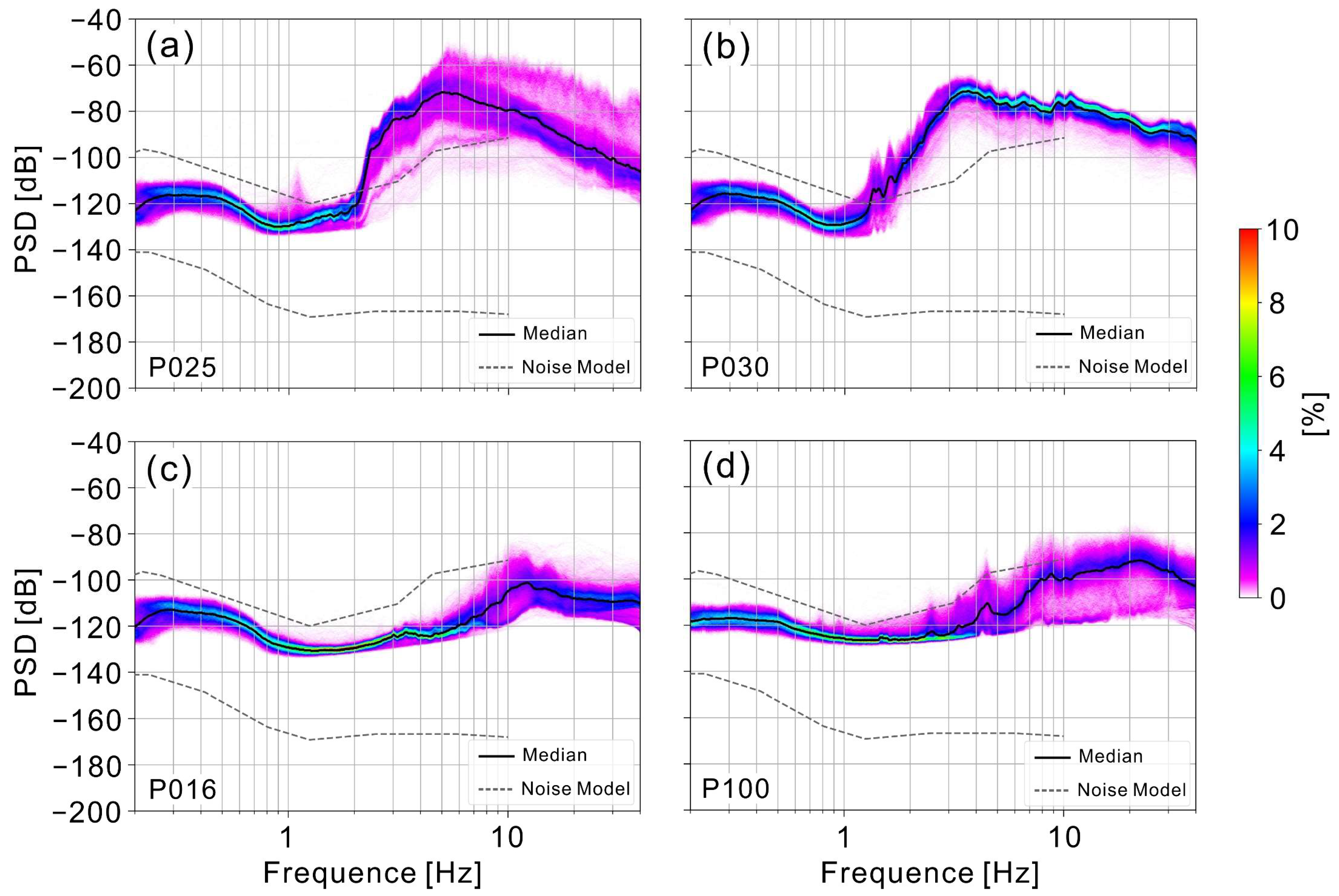

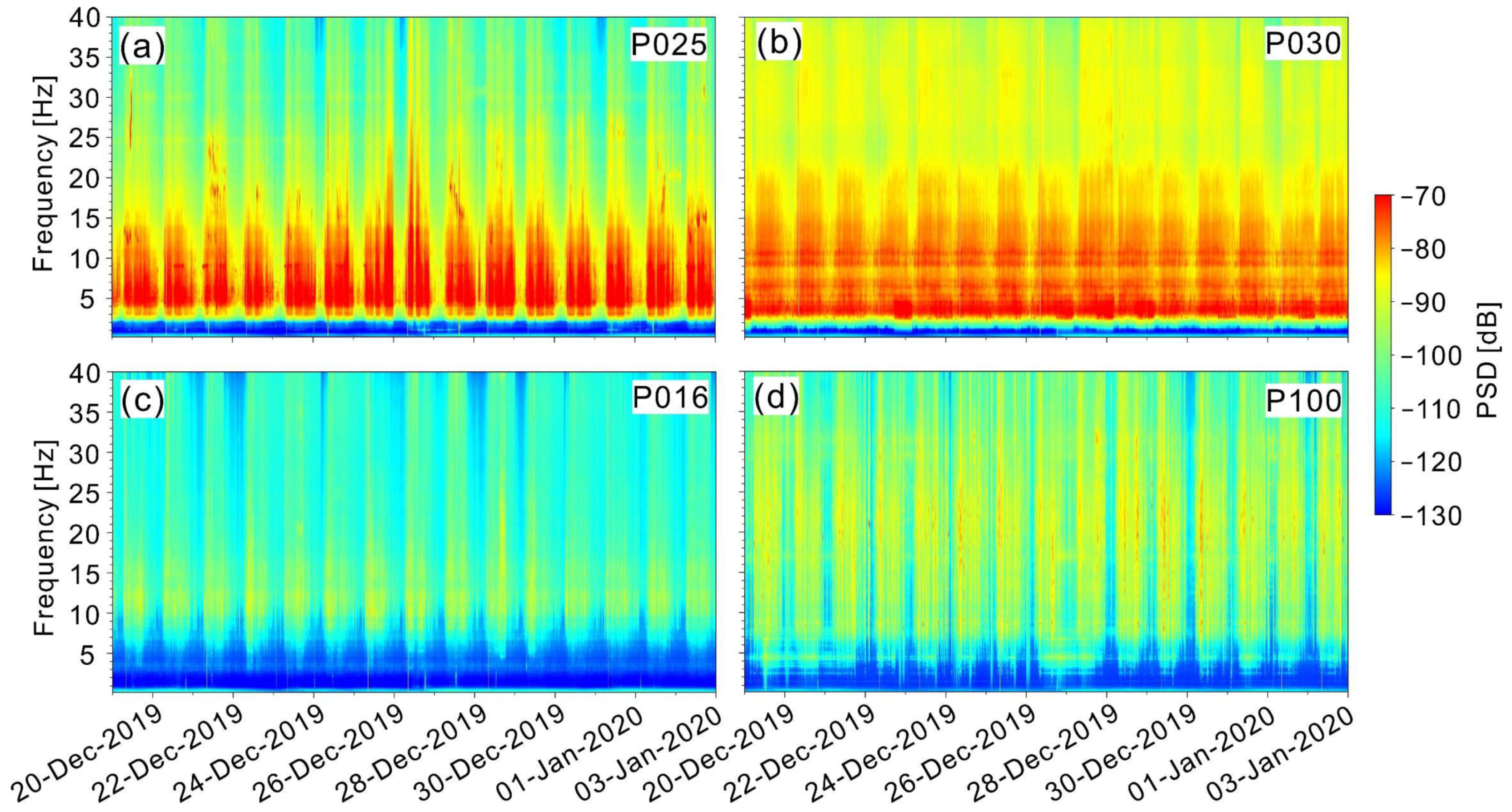
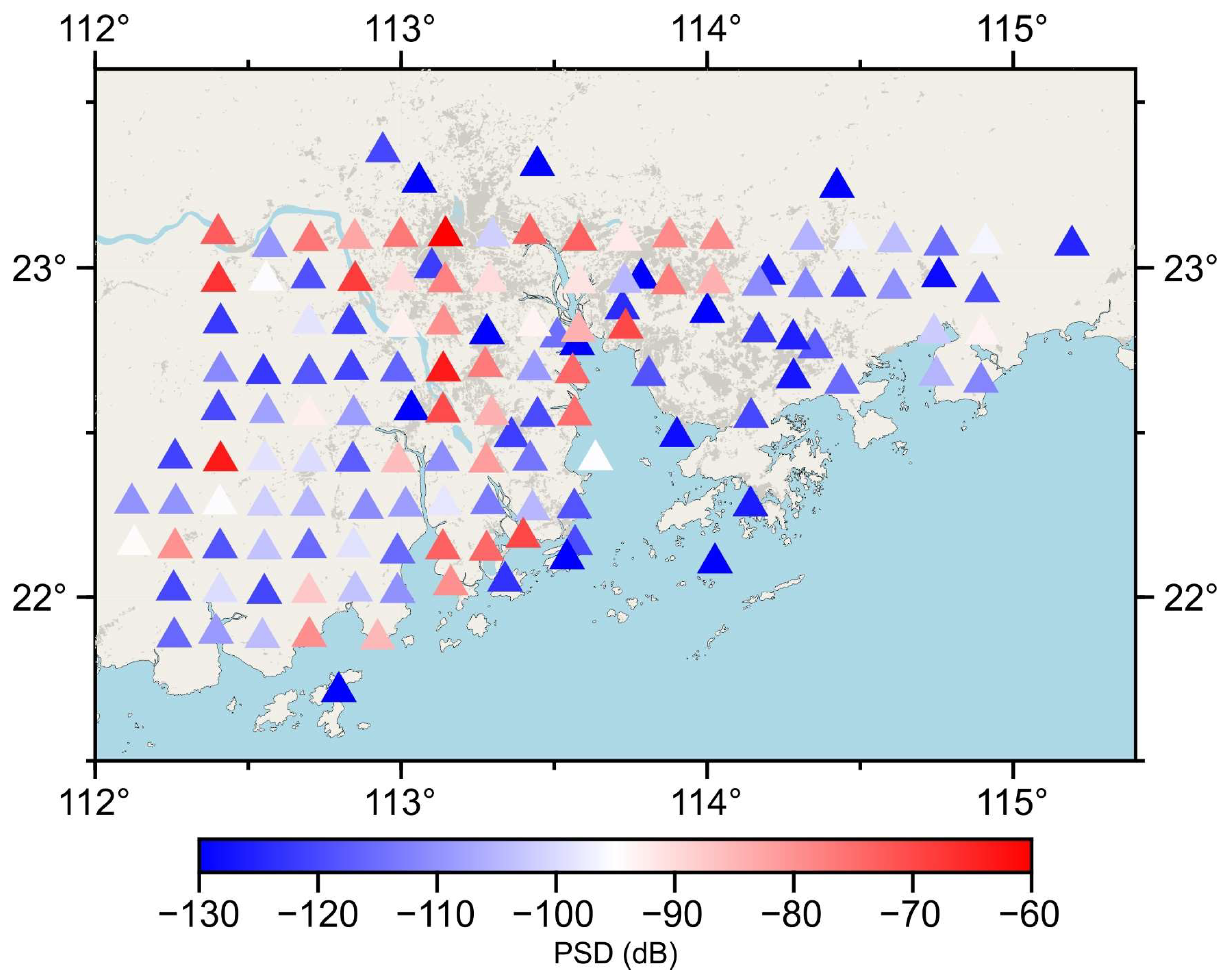
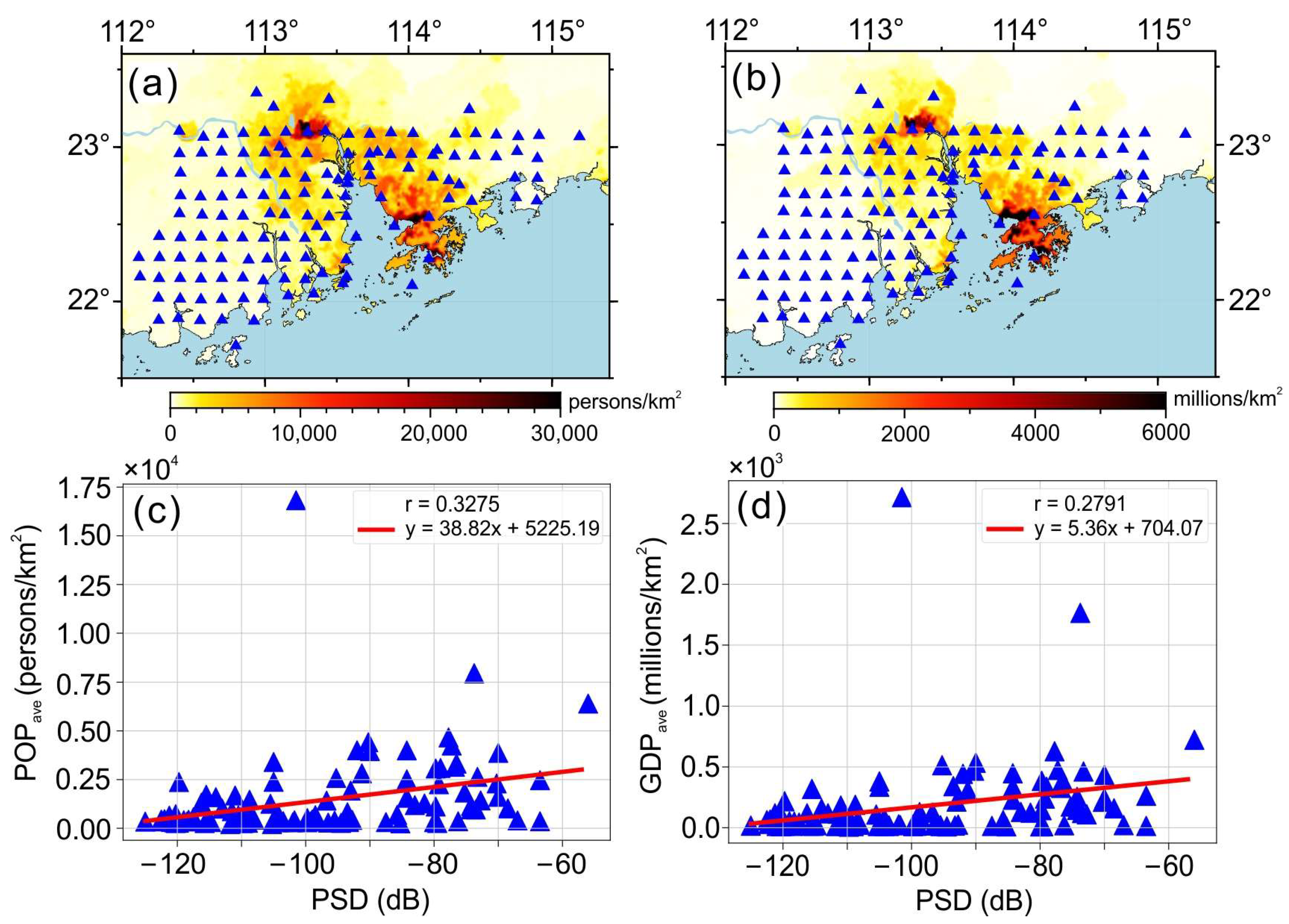

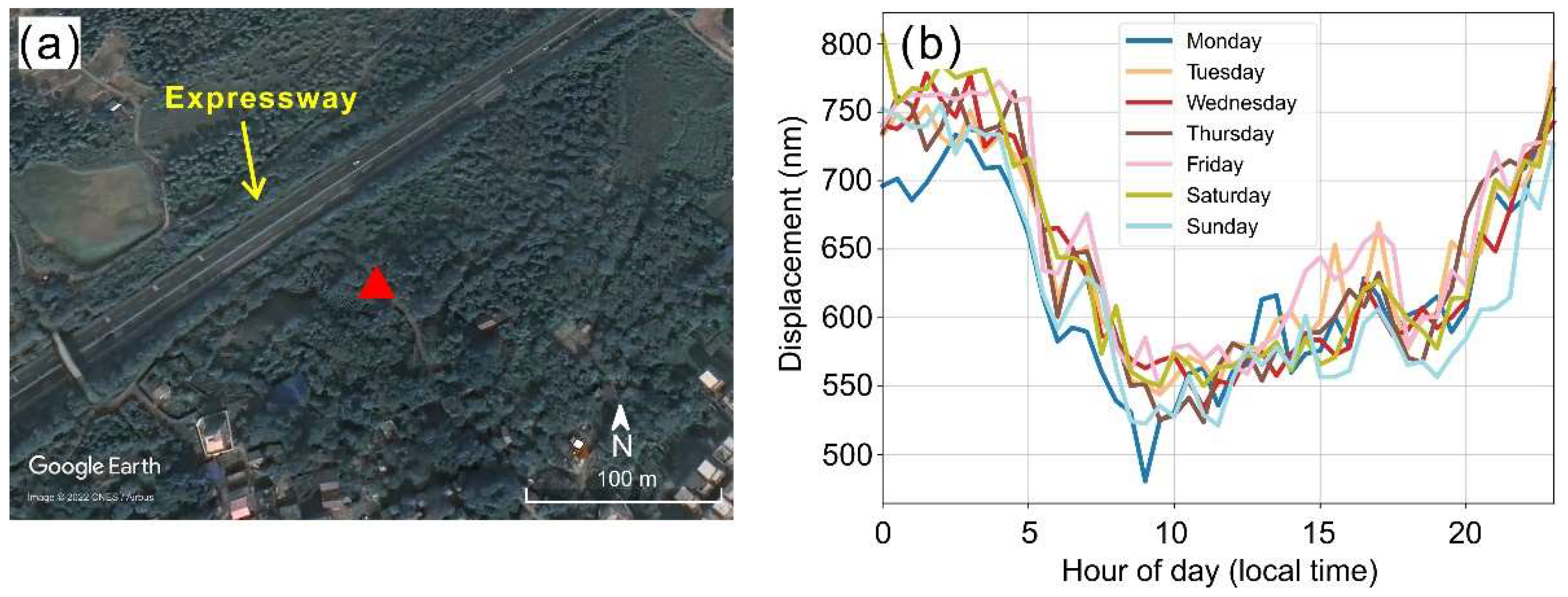
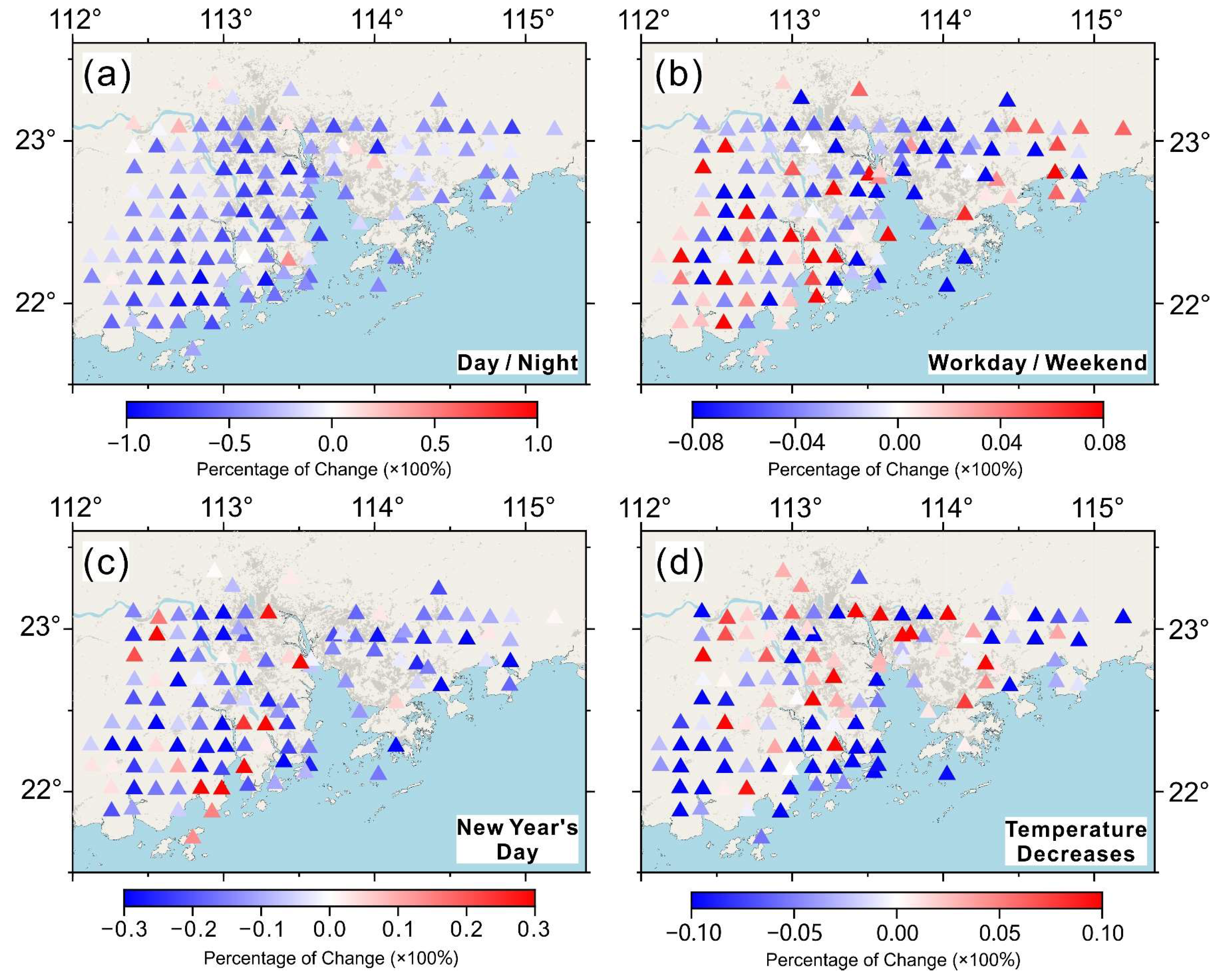

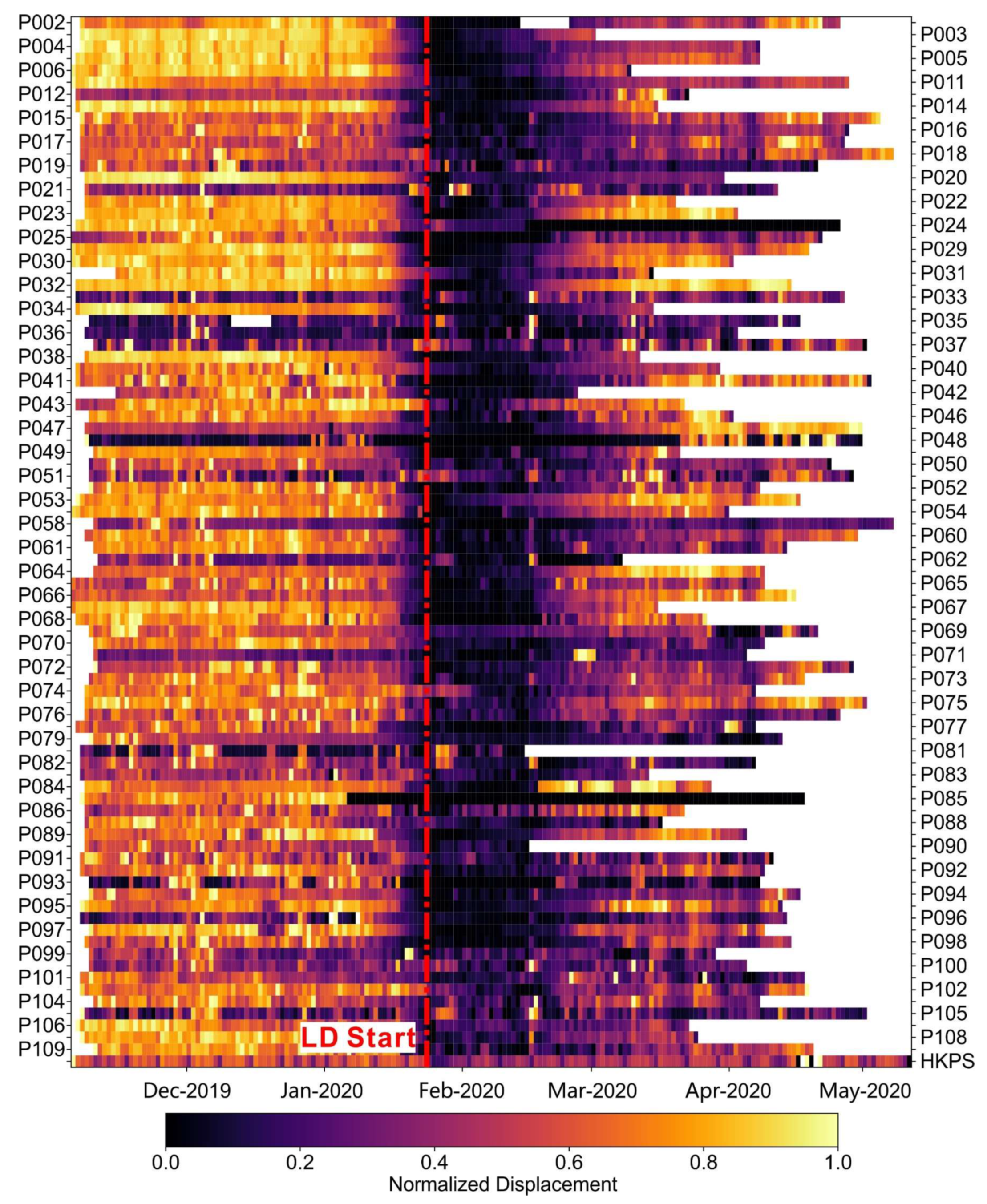
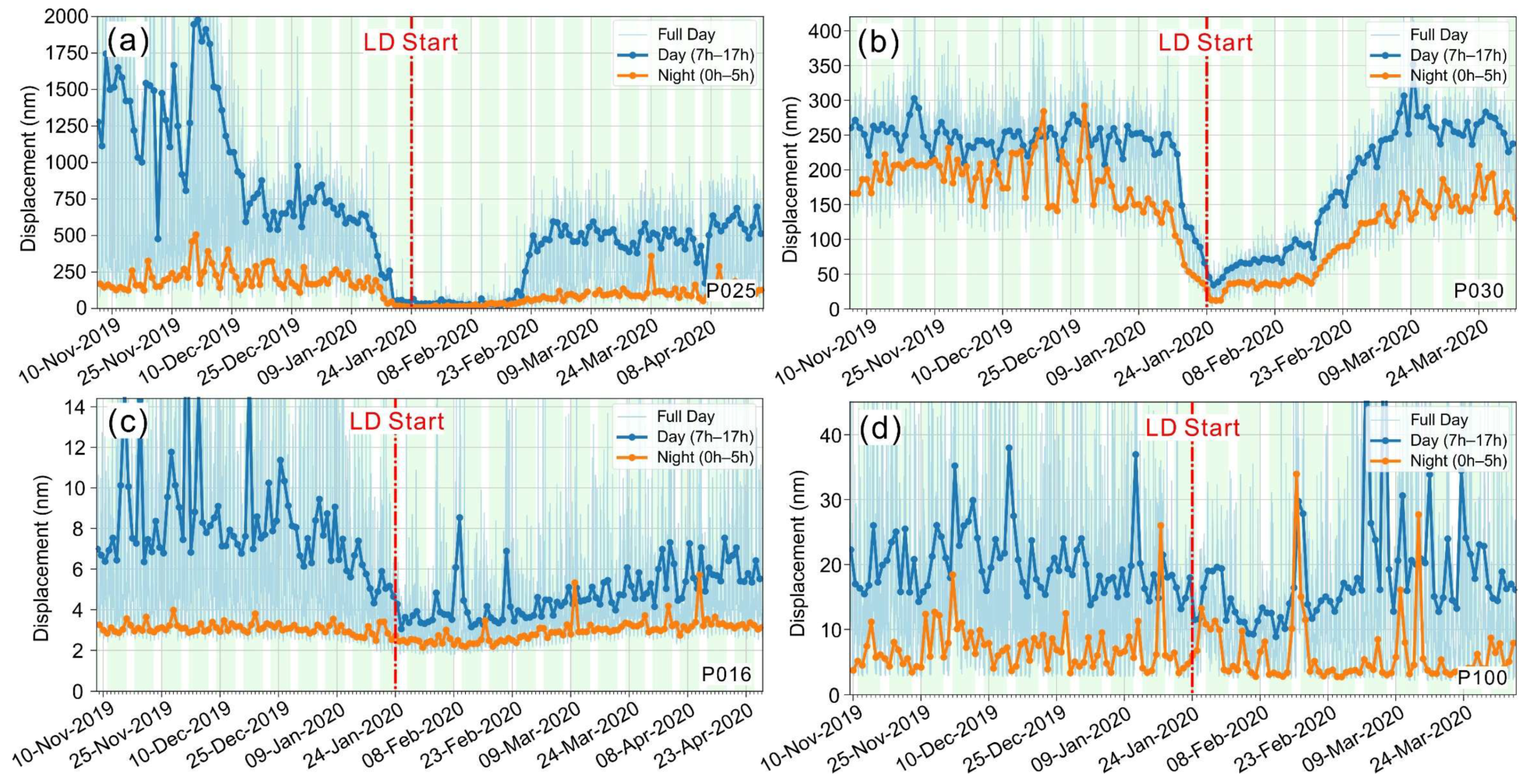


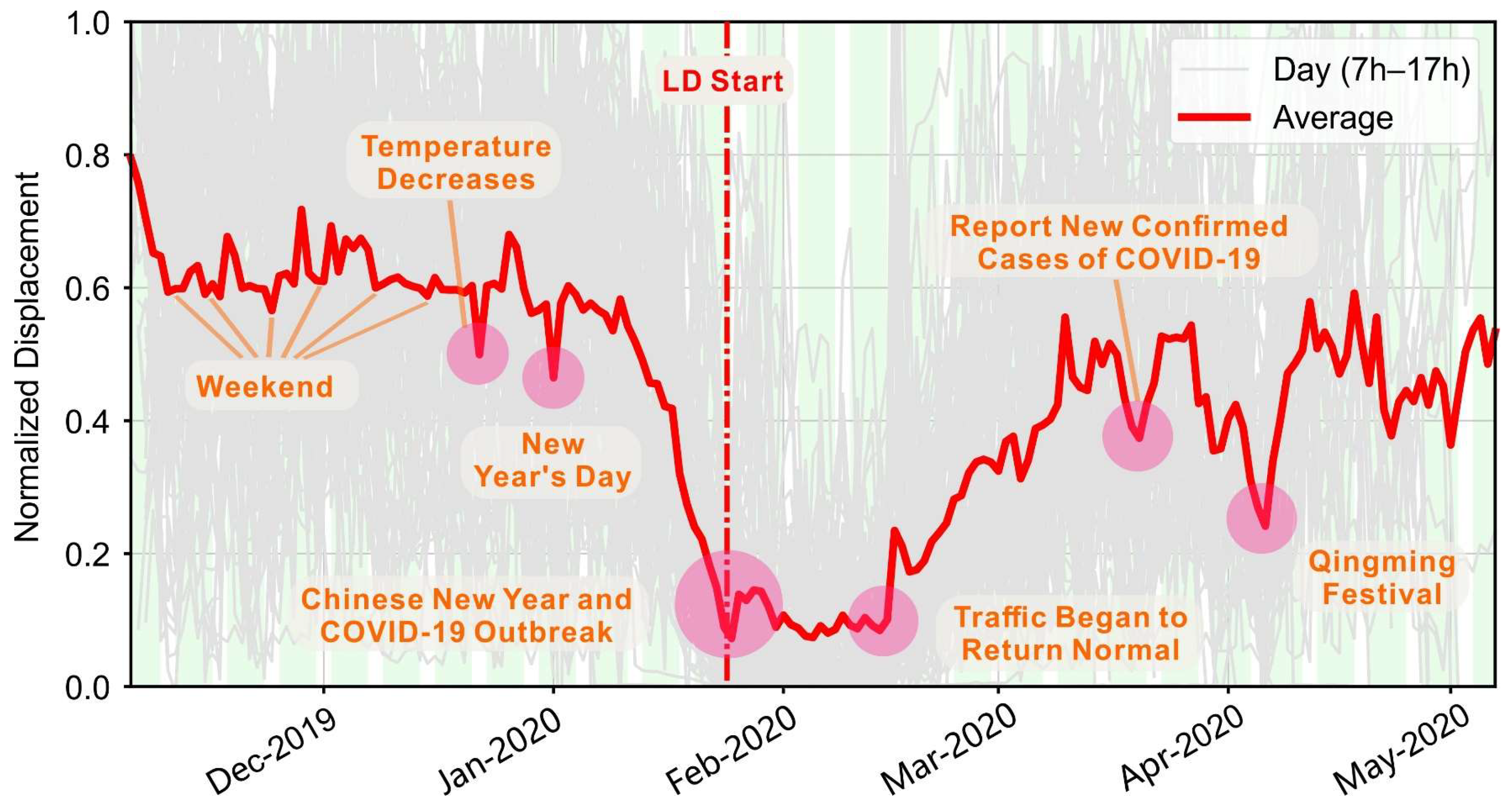
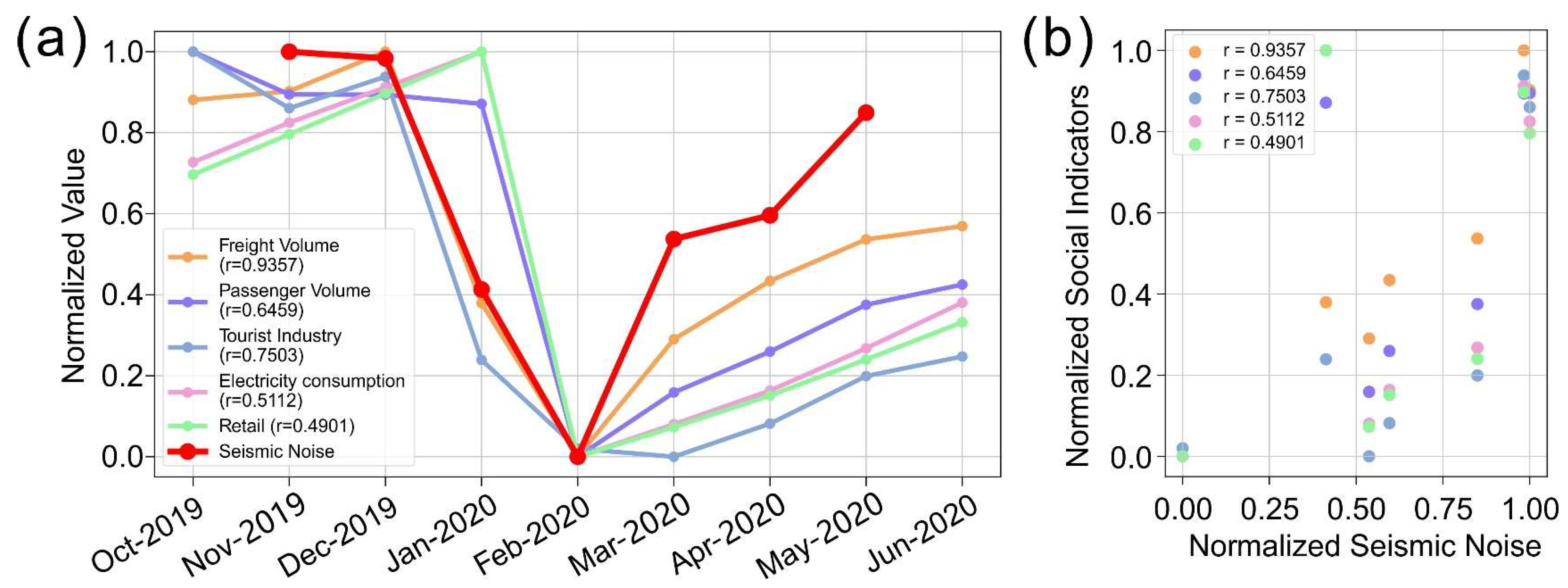
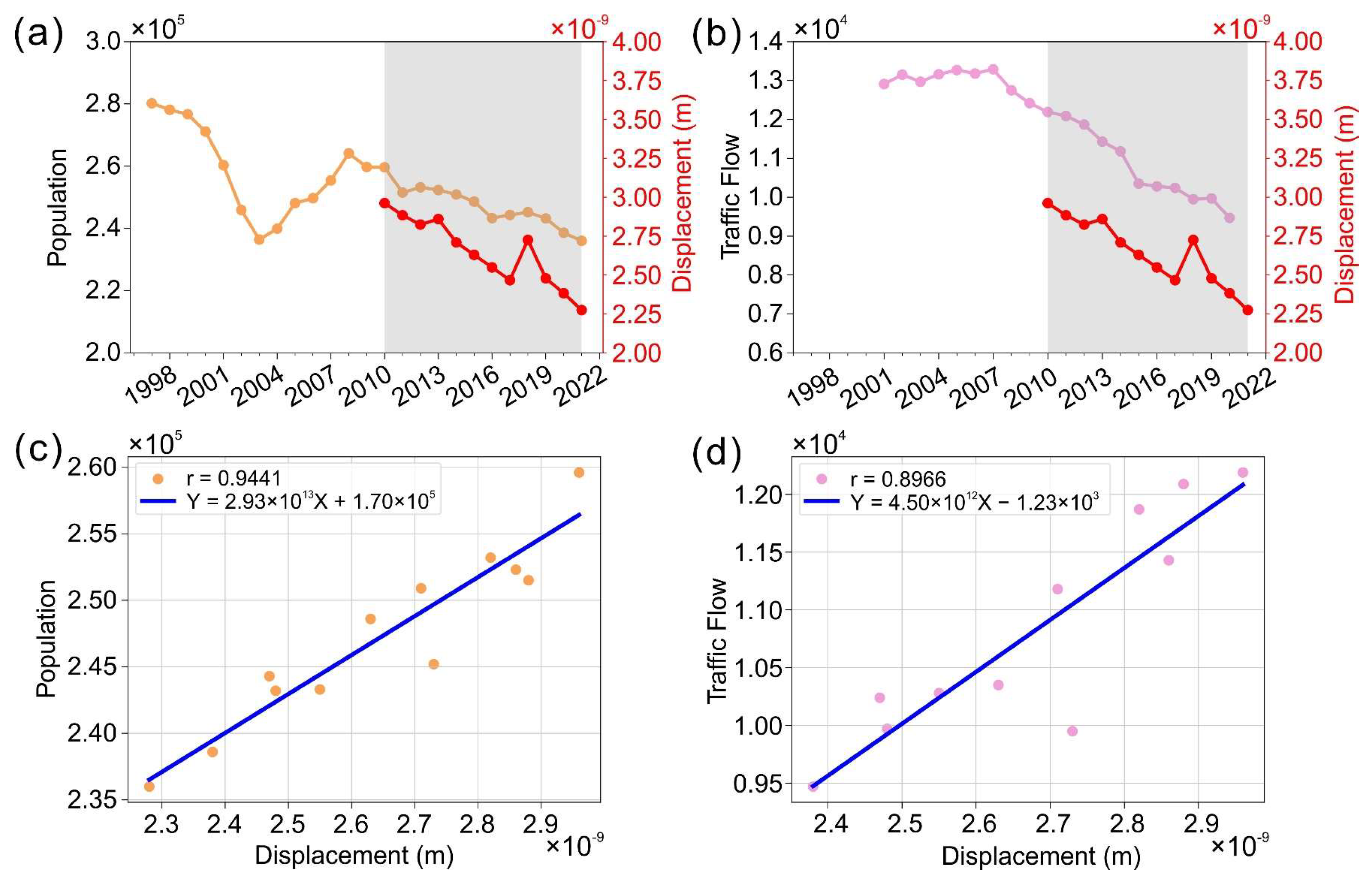
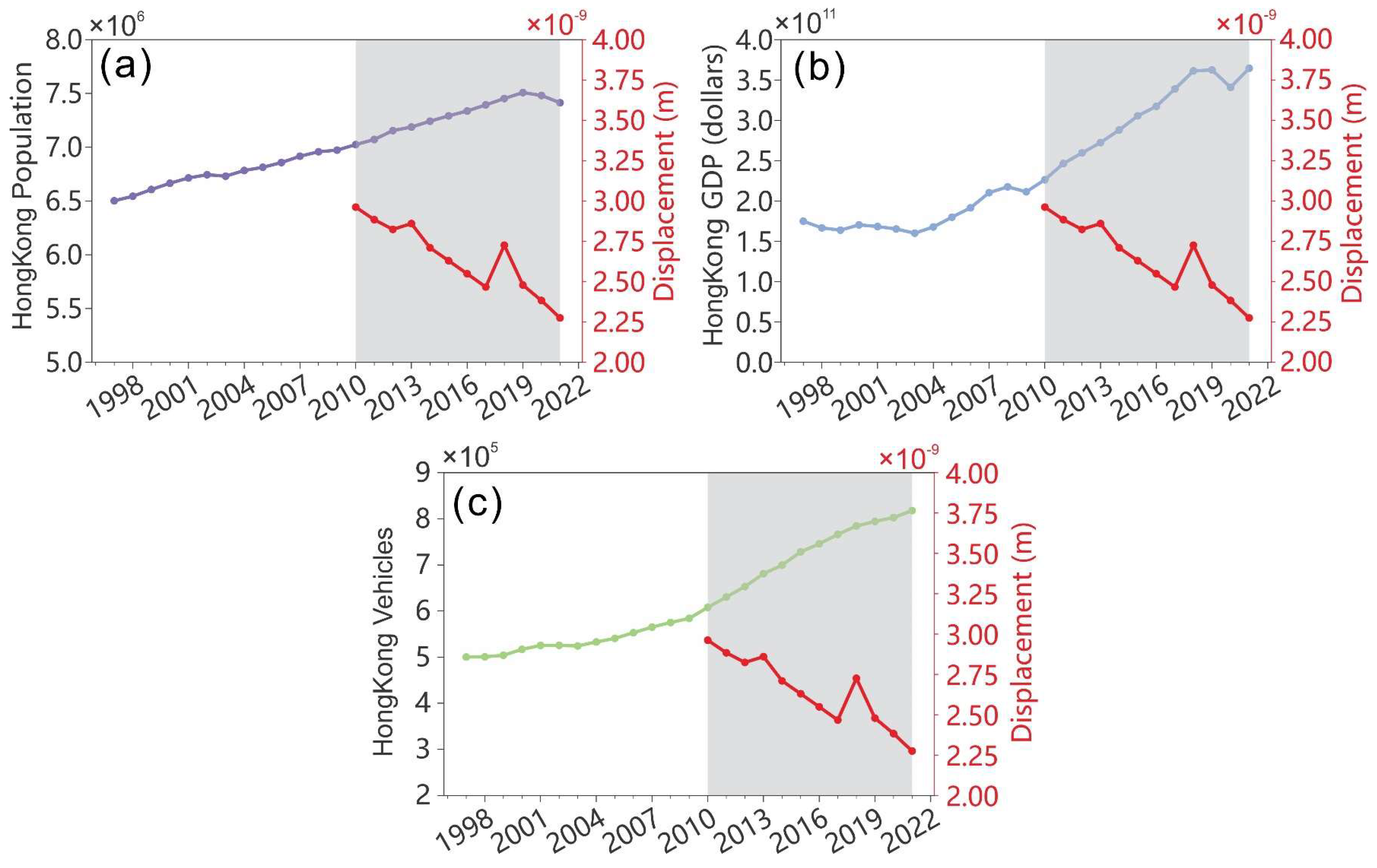
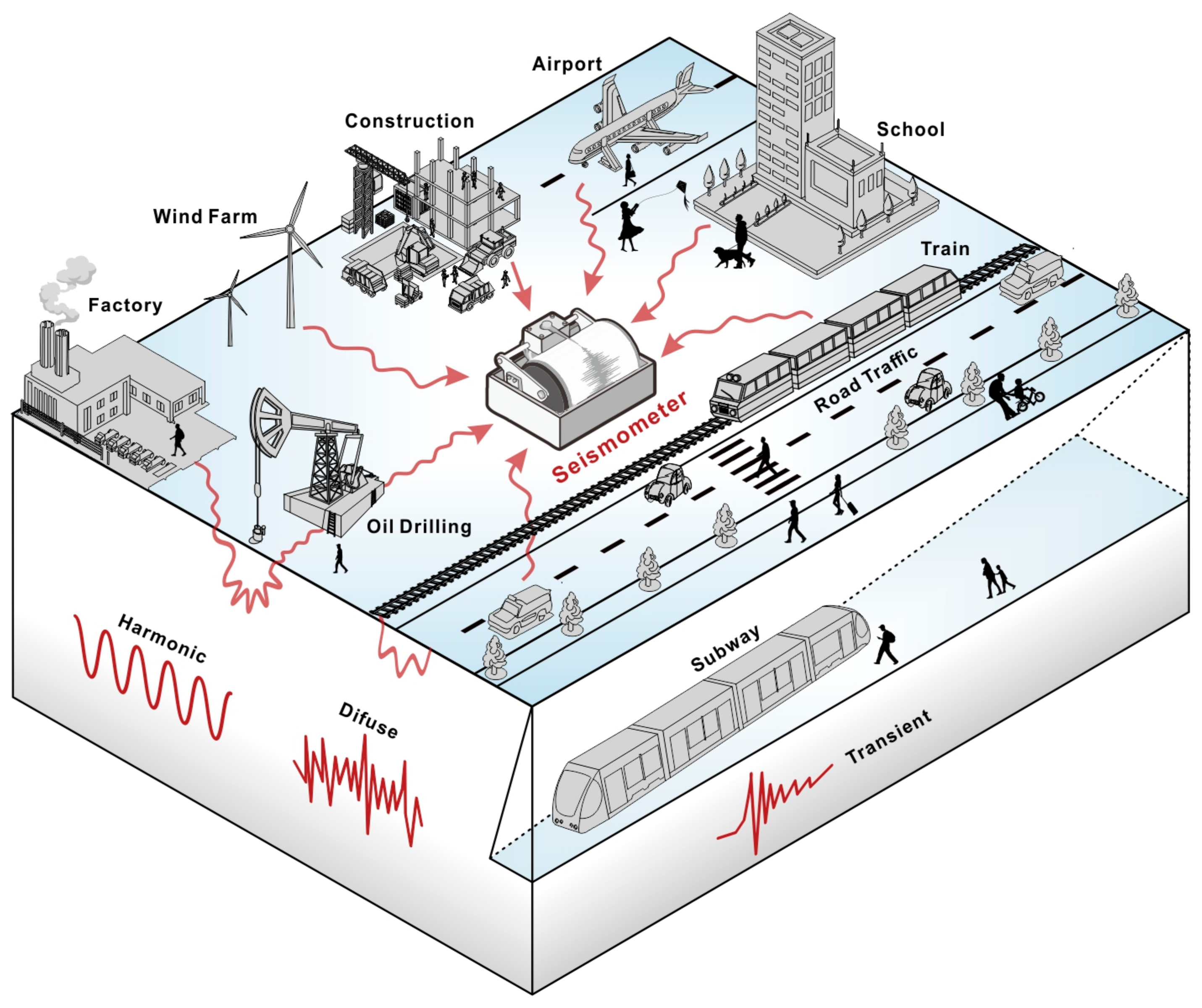
Disclaimer/Publisher’s Note: The statements, opinions and data contained in all publications are solely those of the individual author(s) and contributor(s) and not of MDPI and/or the editor(s). MDPI and/or the editor(s) disclaim responsibility for any injury to people or property resulting from any ideas, methods, instructions or products referred to in the content. |
© 2023 by the authors. Licensee MDPI, Basel, Switzerland. This article is an open access article distributed under the terms and conditions of the Creative Commons Attribution (CC BY) license (https://creativecommons.org/licenses/by/4.0/).
Share and Cite
Chen, L.; Xia, S. Sensing Human Activity of the Guangdong–Hong Kong–Macao Greater Bay Area by Ambient Seismic Noise. Remote Sens. 2023, 15, 5340. https://doi.org/10.3390/rs15225340
Chen L, Xia S. Sensing Human Activity of the Guangdong–Hong Kong–Macao Greater Bay Area by Ambient Seismic Noise. Remote Sensing. 2023; 15(22):5340. https://doi.org/10.3390/rs15225340
Chicago/Turabian StyleChen, Lihui, and Shaohong Xia. 2023. "Sensing Human Activity of the Guangdong–Hong Kong–Macao Greater Bay Area by Ambient Seismic Noise" Remote Sensing 15, no. 22: 5340. https://doi.org/10.3390/rs15225340




